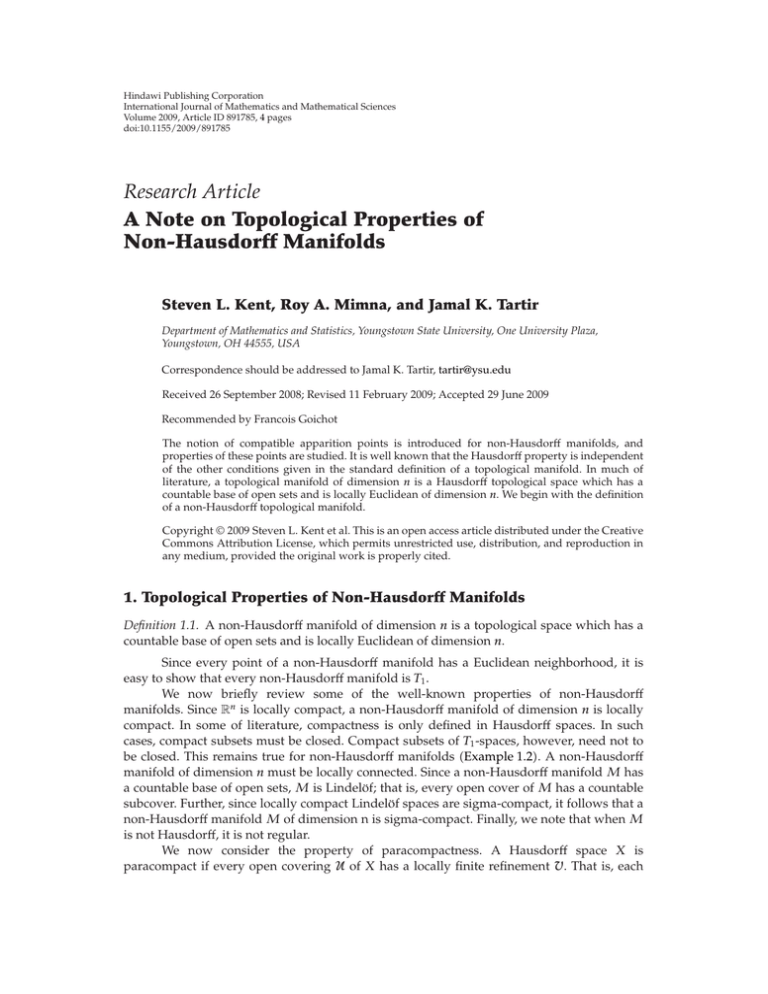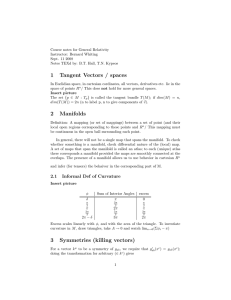Document 10450109
advertisement

Hindawi Publishing Corporation
International Journal of Mathematics and Mathematical Sciences
Volume 2009, Article ID 891785, 4 pages
doi:10.1155/2009/891785
Research Article
A Note on Topological Properties of
Non-Hausdorff Manifolds
Steven L. Kent, Roy A. Mimna, and Jamal K. Tartir
Department of Mathematics and Statistics, Youngstown State University, One University Plaza,
Youngstown, OH 44555, USA
Correspondence should be addressed to Jamal K. Tartir, tartir@ysu.edu
Received 26 September 2008; Revised 11 February 2009; Accepted 29 June 2009
Recommended by Francois Goichot
The notion of compatible apparition points is introduced for non-Hausdorff manifolds, and
properties of these points are studied. It is well known that the Hausdorff property is independent
of the other conditions given in the standard definition of a topological manifold. In much of
literature, a topological manifold of dimension n is a Hausdorff topological space which has a
countable base of open sets and is locally Euclidean of dimension n. We begin with the definition
of a non-Hausdorff topological manifold.
Copyright q 2009 Steven L. Kent et al. This is an open access article distributed under the Creative
Commons Attribution License, which permits unrestricted use, distribution, and reproduction in
any medium, provided the original work is properly cited.
1. Topological Properties of Non-Hausdorff Manifolds
Definition 1.1. A non-Hausdorff manifold of dimension n is a topological space which has a
countable base of open sets and is locally Euclidean of dimension n.
Since every point of a non-Hausdorff manifold has a Euclidean neighborhood, it is
easy to show that every non-Hausdorff manifold is T1 .
We now briefly review some of the well-known properties of non-Hausdorff
manifolds. Since Rn is locally compact, a non-Hausdorff manifold of dimension n is locally
compact. In some of literature, compactness is only defined in Hausdorff spaces. In such
cases, compact subsets must be closed. Compact subsets of T1 -spaces, however, need not to
be closed. This remains true for non-Hausdorff manifolds Example 1.2. A non-Hausdorff
manifold of dimension n must be locally connected. Since a non-Hausdorff manifold M has
a countable base of open sets, M is Lindelöf; that is, every open cover of M has a countable
subcover. Further, since locally compact Lindelöf spaces are sigma-compact, it follows that a
non-Hausdorff manifold M of dimension n is sigma-compact. Finally, we note that when M
is not Hausdorff, it is not regular.
We now consider the property of paracompactness. A Hausdorff space X is
paracompact if every open covering U of X has a locally finite refinement V. That is, each
2
International Journal of Mathematics and Mathematical Sciences
V ∈ V is contained in some U ∈ U and each x ∈ X has a neighborhood N which meets
only finitely many sets in V. Paracompactness can be defined for T1 -spaces as follows. A
T1 -space X is paracompact if and only if each open covering of X has an open barycentric
refinement, where V is a barycentric refinement of U if the collection {Stx, V : x ∈ X} refines
U, where Stx, V ∪{V ∈ V : x ∈ V }. A space is metacompact if every open cover has a
point finite refinement. Since Hausdorff second countable manifolds are metrizable, they are
paracompact and hence metacompact. In 1, an example of a non-Hausdorff manifold which
is not metacompact is given. We present another one.
Example 1.2. A non-Hausdorff manifold M need not to be metacompact.
Let M R ∪ Q × {1} and define a topology on M as follows.
i For each x ∈ R, a basic open neighborhood of x is open in R with the usual topology.
ii For each q, 1 ∈ Q×{1}, a basic open neighborhood of q, 1 is of the form {q, 1}∪
U \ {q} where U is an open neighborhood of q in R with the usual topology.
Claim 1. The non-Hausdorff manifold M is not metacompact.
Proof. Let U {{q, 1} ∪ R : q ∈ Q}. To see that U has no point finite refinement, let V
be a refinement of U. Let q0 ∈ Q and ε0 > 0 such that q0 − ε0 , q0 ε0 is a subset of some
element of V. For each n ∈ N, choose qn ∈ Q, εn > 0, and Vn ∈ V such that qn − εn , qn εn ⊆
qn−1 − εn−1 , qn−1 εn−1 \ {qn−1 }, εn < 1/n, and {qn , 1} ∪ qn − εn , qn εn \ {qn } ⊆ Vn .
By the way U is defined, no element of U contains more than one element of Q × {1}. Since
V is a refinement of U, no element of V contains more than one element of Q × {1}. Hence,
k. By Cantor’s Intersection theorem, there exists x ∈ R such that {x} V V whenever j /
j∞/ k
q
−
ε
,
q
ε
⊆ ∞
n
n
n
n
n1
n1 Vn . Therefore, V is not point finite.
Remark 1.3. In the above example, 0, 1 is compact and Hausdorff but not closed.
Remark 1.4. For each n ∈ N, Rn is a complete metric space and Qn is a countable dense subset
of Rn . Therefore, a construction similar to the one above can be used to create a non-Hausdorff
manifold of dimension n that is not metacompact.
2. Compatible Apparition Points
If a manifold M of dimension n is non-Hausdorff, there exist at least two points x and y which
cannot be separated by disjoint open sets. Also, the points x and y cannot be contained in the
same Euclidean neighborhood since Euclidean neighborhoods are Hausdorff.
Definition 2.1. Let M be a non-Hausdorff manifold and let x and y be distinct points of M.
Then x and y are compatible apparition points if there do not exist disjoint open sets U and
V with x ∈ U and y ∈ V . By a “set of compatible apparition points,” we will mean that any
pair of distinct points in the set are compatible apparition points.
Remark 2.2. Since a non-Hausdorff manifold is locally Hausdorff, then no more than one
element of a set of compatible apparition points can be contained in a single Euclidean
neighborhood. Hence, a set of compatible apparition points is a closed discrete set.
International Journal of Mathematics and Mathematical Sciences
3
Remark 2.3. Since a non-Hausdorff manifold has a countable base and each point is contained
in its own Euclidean neighborhood, any set of compatible apparition points must be
countable.
A non-Hausdorff manifold can have an uncountable collection of sets of compatible
apparition points.
Example 2.4. Let C denote the Cantor ternary set and define X R ∪ C × {0}. Define a
topology on X as follows.
i For each x ∈ R, a basic open neighborhood of x is open in R with the usual topology.
ii For each x ∈ C, a basic open neighborhood of x, 0 is of the form x − ε, x ε ∩
C × {0} ∪ x − ε, x ε \ C.
Note that for each x ∈ C, {x, x, 0} is a set of compatible apparition points. Also, note
that since each ε can be chosen to be rational, X is second countable.
Recall that a subset of a topological space is nowhere dense if the interior of its closure
is empty.
Proposition 2.5. Let S be a set of compatible apparition points in a non-Hausdorff manifold M. Then
S is nowhere dense in M.
Proof. Since S is closed and discrete and every element of M has a Euclidean neighborhood,
S is the frontier of M \ S which is open. Hence, S is nowhere dense by 2, 4G part 2 on page
37.
Proposition 2.6. Let M be an n-dimensional non-Hausdorff manifold. Suppose that M contains
a nonempty set S of compatible apparition points. Then every continuous function from M to a
Hausdorff space X is constant on S.
Proof. Suppose that f : M → X is continuous. Attempting a contradiction, suppose that
fx2 . Since X is Hausdorff, there are disjoint open sets U1 , U2 ⊆ X
x1 , x2 ∈ S such that fx1 /
such that fx1 ∈ U1 and fx2 ∈ U2 . Then f −1 U1 and f −1 U2 are disjoint open subsets of
M with x1 ∈ f −1 U1 and x2 ∈ f −1 U2 , a contradiction.
Theorem 2.7. In a non-Hausdorff manifold, the set of points which are not apparition points is
dense.
Proof. Suppose that M is a non-Hausdorff manifold. Since M is locally Hausdorff, Lemma 4.2
of 3 implies that each x ∈ M has a dense open Hausdorff neighborhood Ux . Since M is
Lindelöf, the cover {Ux }x∈M has a countable subcover C. Since M is Baire, ∩C is dense in M.
Since the elements of C are Hausdorff, any point in ∩C can be separated from any other point
in M. Therefore, ∩C is a dense set of nonapparition points.
Acknowledgments
The authors would like to thank the referee for numerous helpful suggestions. The referee
was particularly helpful in improving Theorem 2.7.
4
International Journal of Mathematics and Mathematical Sciences
References
1 P. Gartside, D. Gauld, and S. Greenwood, “Homogeneous and inhomogeneous manifolds,” Proceedings
of the American Mathematical Society, vol. 136, no. 9, pp. 3363–3373, 2008.
2 S. Willard, General Topology, Dover, Mineola, NY, USA, 2004.
3 M. Baillif and A. Gabard, “Manifolds: Hausdorffness versus homogeneity,” Proceedings of the American
Mathematical Society, vol. 136, no. 3, pp. 1105–1111, 2008.





